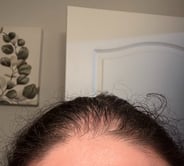Understanding and Addressing Front Hair Loss in Women
4/28/20253 min read
Hair loss is often considered a “male problem,” but the reality is that millions of women experience it too—and it can be incredibly emotional and frustrating. One specific type that many women notice is front hair loss, where thinning or a receding hairline occurs around the forehead or temples.
If you’re dealing with front hair loss, know that you’re not alone—and there are steps you can take to understand, manage, and even reverse it. Here’s what you need to know.
What Causes Front Hair Loss in Women?
Several factors can contribute to hair thinning at the front of the scalp:
1. Androgenetic Alopecia (Female Pattern Hair Loss)
This is the most common cause of hair loss in women. Unlike male pattern baldness, women usually experience diffuse thinning rather than complete bald spots. In some cases, thinning is more pronounced at the hairline and temples.
2. Traction Alopecia
This type of hair loss is caused by repeated tension on the hair from styles like tight ponytails, braids, extensions, or buns. Over time, this stress can weaken hair follicles and cause permanent damage if not addressed early.
3. Hormonal Changes
Events like pregnancy, menopause, thyroid imbalances, or birth control changes can significantly affect hair growth. Estrogen, in particular, plays a role in maintaining hair density.
4. Stress
Physical or emotional stress can trigger a condition called telogen effluvium, where more hair than usual shifts into the shedding phase of the hair growth cycle.
5. Nutritional Deficiencies
Low levels of iron, vitamin D, zinc, and biotin can all impact hair health. Hair follicles are sensitive to your body’s nutritional state.
6. Medical Conditions and Medications
Autoimmune diseases like alopecia areata, scalp infections, and certain medications (including chemotherapy) can also cause front hair loss.
Signs You Might Be Experiencing Front Hair Loss
Widening part or noticeable thinning along the hairline
Receding forehead line
Decrease in baby hairs at the temples
Difficulty styling hair as usual due to less density at the front
Hairline that looks uneven or patchy
Early detection can make a big difference in treatment success, so pay attention to subtle changes.
How to Treat and Manage Front Hair Loss
1. Visit a Dermatologist or Trichologist
Before trying treatments on your own, consult a professional. They can diagnose the underlying cause and suggest a targeted plan.
2. Use Minoxidil
Minoxidil (often sold as Rogaine) is FDA-approved for women and can stimulate hair growth and slow down hair thinning. It’s typically applied topically once or twice daily.
These are REAL photo results from our owner Sophee
Before
Exactly 1 month After
3. Adjust Your Hairstyles
Avoid tight styles that pull on your hairline. Opt for loose ponytails, soft braids, or letting your hair down when possible to reduce tension on your scalp.
4. Improve Your Nutrition
Focus on a diet rich in:
Lean proteins (essential for keratin production)
Iron-rich foods (like spinach and lentils)
Omega-3 fatty acids (found in salmon, walnuts, flaxseeds)
Vitamins D, C, and B-complex
Consider supplements if your doctor recommends them.
5. Manage Stress
Incorporate stress-reducing activities into your routine:
Meditation or mindfulness
Gentle exercise like yoga
Prioritizing sleep
Talking to a therapist if needed
Reducing stress can balance hormone levels and support hair regrowth.
6. Try Scalp Treatments
Scalp massages with nourishing oils (like rosemary, peppermint, or castor oil) can stimulate circulation and promote a healthier environment for hair growth.
New and Emerging Treatments
In addition to traditional approaches, there are exciting developments in hair restoration:
Platelet-Rich Plasma (PRP) Therapy: A dermatologist draws your blood, processes it to concentrate the platelets, and injects it into your scalp to encourage regrowth.
Microneedling: Tiny needles create micro-injuries in the scalp to stimulate collagen production and hair growth.
Here's a Best Seller - Dermaroller
Low-Level Laser Therapy (LLLT): Devices like laser combs or caps can encourage hair follicles to grow stronger hair over time.
Always consult with a professional before starting advanced treatments.
Preventing Further Hair Loss
Even if you’re seeing hair loss now, you can still protect the hair you have by:
Avoiding harsh chemical treatments (like frequent bleaching or relaxing)
Using a satin pillowcase to minimize hair breakage while sleeping
Limiting heat styling tools and using heat protectants
Gently detangling hair with a wide-tooth comb
Taking a proactive, gentle approach to hair care can help maintain and improve your hair health.
Final Thoughts: Front Hair Loss Is Manageable
Hair loss can feel deeply personal and discouraging, but there are solutions—and there is hope. Identifying the root cause, nurturing your scalp and body, and exploring available treatments can lead to real, noticeable improvements over time.
Remember: progress might be slow, but every step you take toward caring for yourself counts. Whether you regrow your hair, find a new favorite hairstyle, or simply embrace your journey, know that you are beautiful at every stage.
Disclosure - When you use our link to buy something, we may earn a small commission—at no extra cost to you!



